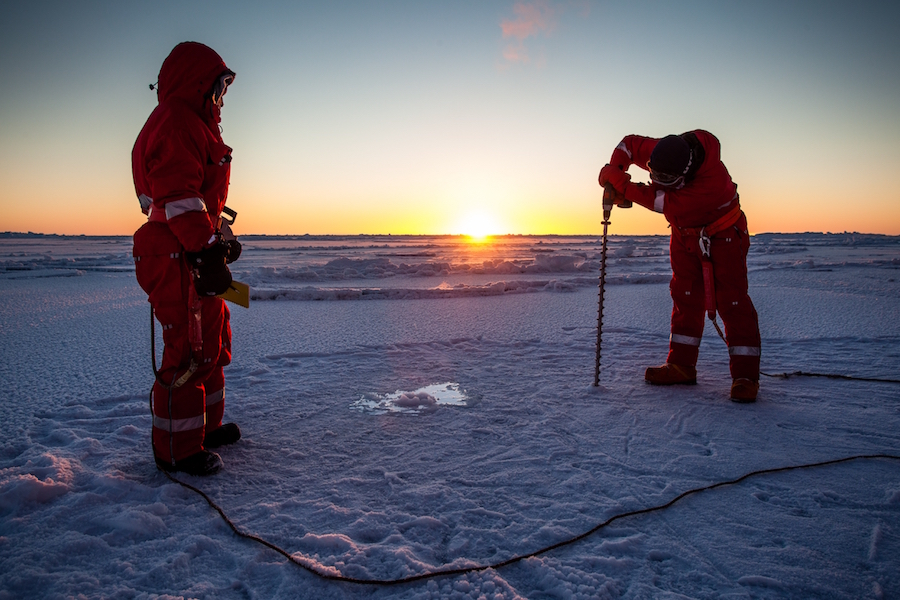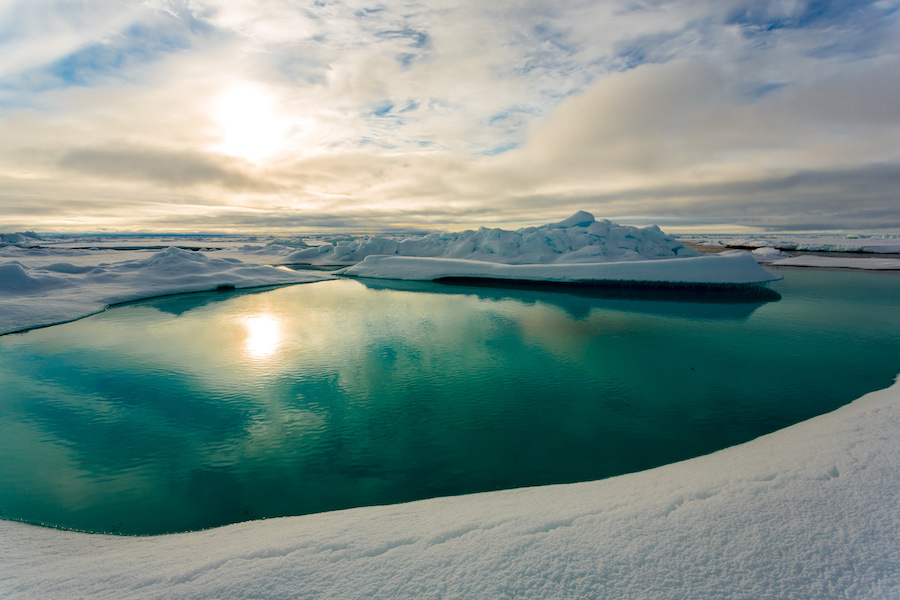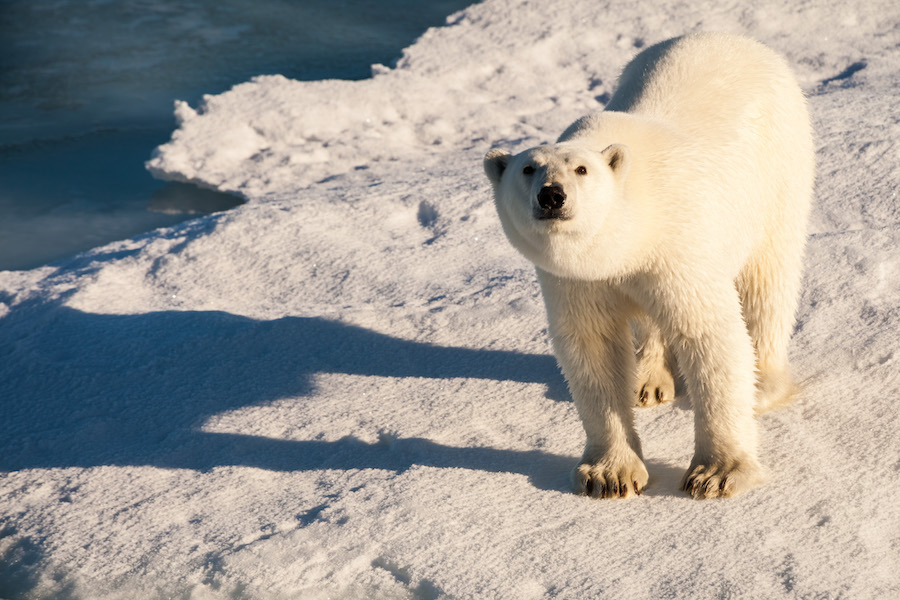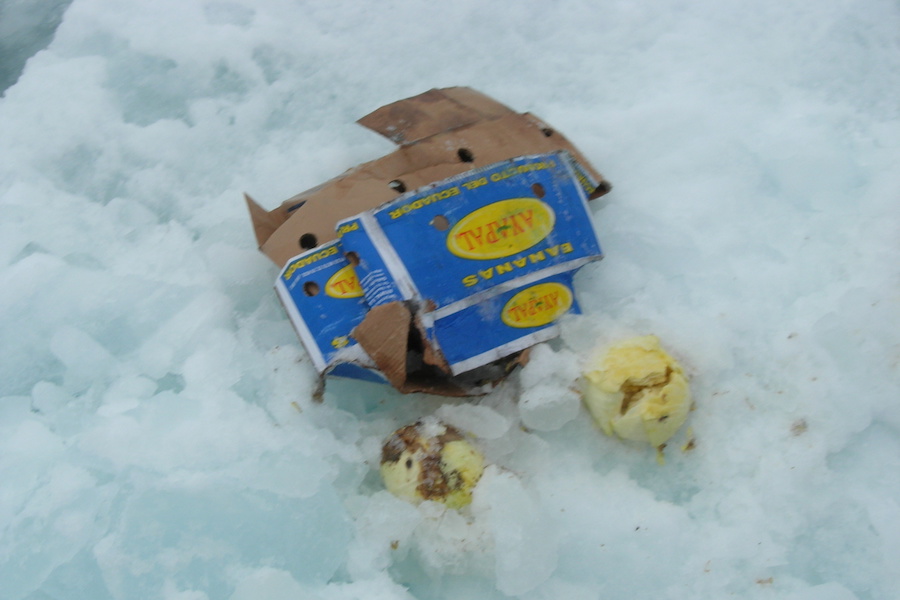The Arctic Ocean
12 percent is the average rate of decline of the Arctic summer ice per decade. Scientists are concerned that the Arctic Ocean might be completely ice-free towards the end of the summer already in a few decades.

The winter ice extent is also declining. In February 2018, the extent of the ice shield covering the Arctic Ocean and surrounding waters dropped to its lowest level since the beginning of satellite records in 1978 and only covered about 14 million square kilometres. This means that Arctic winter sea ice is melting at a rate of 2.75 percent every ten years. Researchers have also been measuring the thickness of the ice cover for many years now and found that it, too, is declining. The thinning of the ice shield can cause cracks on the surface which in turn intensify climate change further: A thick ice shield reflects the sunlight and protects the ocean below from warming; in contrast, areas of open water between ice floes (called leads) absorb much more heat than the ice floes themselves. This raises the temperature of the water, which in turn accelerates the melting process.
The warming of the ocean
The Arctic Ocean covers a surface of more than 14 million square kilometres, making it almost the size of Antarctica. Despite being the smallest and shallowest of the world’s five major oceans, the changes happening there have the biggest impact on global climate. The temperature of its middle layer has increased by 0.9 degrees Celsius every ten years since the 1970s. Researchers have been observing these changing temperatures in the Arctic Ocean for years in order to learn more about Arctic climate change. Policy-makers, too, are following these developments ever more closely. A total number of 195 countries approved the first binding universal climate agreement at the Paris Climate Change Conference (COP21) in December 2015. The Paris Agreement aims to limit global warming to well below 2°C. This is a particular challenge with regard to the Arctic.

Global weather is changing
As a regulator of polar temperature the ice also influences the weather worldwide. This is because the ocean and air currents act as engines which transport heat to the poles to balance our planet’s temperatures. One of these mechanisms is the movement of air across great distances. The other, slower method occurs under water, where ocean currents transport heat along a “global conveyor belt”. This system is based on local differences in temperature and salinity and influences our weather at sea and on land.
The dwindling of the Arctic sea ice has a major impact on this process. Despite its cold temperatures, the water of the Arctic Ocean is still warmer than the surrounding air in the winter. This means that the ice cover acts as a type of insulation. Where it melts and breaks, leads appear that release the warmer temperatures of the water into the atmosphere.
The effect of global warming: extreme weather phenomena and methane gas release
It is a well-known fact that global warming can cause more frequent episodes of severe weather. The loss of Arctic sea ice could accelerate this process even further. Areas of continuous ice would normally limit evaporation into the atmosphere. A receding ice shield is fuel for the development of stronger storms: If the ice cover recedes or breaks, storms can form more easily and waves become bigger.
The melting of sea ice also causes the release of methane, an important greenhouse gas. The Arctic tundra and marine sediments are great stores of frozen methane. It poses a major climate risk if rising temperatures thaw these reservoirs and the greenhouse gas is released into the atmosphere.
Loss of habitat

The changes are also affecting the flora and fauna in the Arctic. Polar bears are losing their natural hunting grounds while native species are increasingly competing for food and habitat with newly introduced species. Ice algae that used to provide the basic food resource in the Arctic ecosystem are losing habitat both in and under the ice – the impact of this development on the Arctic food chain is still unknown. Last but not least, the changes will also affect humans as fishing grounds change.
Fishing ban in the Arctic
A commercial fishing ban for at least 16 years is envisaged for an area covering 2.8 million square kilometres around the North Pole. This was agreed by the European Union, Denmark, Norway, Iceland, Canada, China, Japan, South Korea, Russia and the United States in December 2017. The agreement will enter into force upon ratification by the ten Parties. However, the expected increase in fish stocks and declining sea ice extent in the Arctic could rekindle commercial interests over the next decades.
Fishing nets polluting the oceans
The fishing ban eases another major problem, namely the pollution of the Arctic Ocean. The improper disposal of fishing nets and other discarded fishing gear such as buoys and rope complicate the problem of plastic waste in the oceans. Big vessels such as cruise or container ships and human littering of bags, bottles, buckets and other plastic items also contribute towards the pollution of the Arctic Ocean. Once plastic debris has entered the water it is almost impossible to identify the polluter. What is more, the Arctic Ocean is considered a dead end for ocean plastic: Once it has reached the Arctic via the various ocean currents, it almost always gets trapped in the ice.
Trapped in Arctic gyres

The Arctic coastline is so sparsely populated that coastal residents alone cannot be the root cause of the ocean’s pollution. The large part of marine plastic reaches the Arctic via the big ocean gyres that originate along the equator and are also called “garbage patches”. There are currently five such garbage patches. They form where ocean currents from the North and South meet, causing an accumulation of marine litter. However, the currents do not only transport large parts of plastic litter such as bags or bottles but also much smaller particles called microplastics.
Microplastics are often discharged into the environment through the cleansing agents, shampoo or washing powder contained in wastewater and after washing synthetic fibres. Up to 12,000 particles can be found in only one litre of Arctic sea ice. Marine debris poses a particular threat for animals that are likely to swallow small particles or get entangled in larger parts.
Sustainable management required
Human-caused waste is not the only stress on the marine ecosystem. The shrinking of the ice shield also means that ship traffic is increasing along the Russian and Canadian coasts and that more areas are being developed for tourism. These trends, too, increase the plastic pollution of the Arctic Ocean and mean that both humans and animals are increasingly exposed to exhaust emissions and noise pollution. Native populations, tourism operators, tourists, industry representatives and policy-makers all need to address these challenges for the sake of protecting the fragile Arctic ecosystem.
Will the Arctic be ice-free in 2050?
The rate at which the Arctic ice cover melts depends on many different factors such as air and water temperatures and ocean currents. We are already seeing a dramatic loss of summer sea ice. This gives researchers and scientists reason to believe that the Arctic will be completely ice-free at the end of the summer season as early as in 30 to 50 years’ time. However, they also believe that the ice shield will mostly recover over the winter. Researchers from 17 different countries will be going on a one-year expedition in the Arctic starting in September 2018 in order to collect more data on the Arctic winter. The project entitled “Multidisciplinary drifting Observatory for the Study of Arctic Climate” (MOSAiC) will complement and expand the existing database on interactions of atmosphere, ice, ecosystem and the ocean.